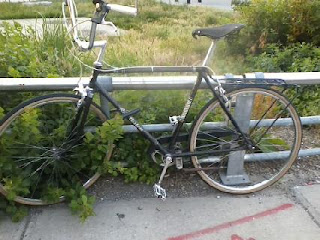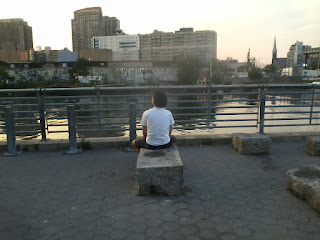Perhaps you've done something like what I am about to describe.
I packed lunch-- salsa I made myself, with some excellent locally-made tortilla chips--into the front bag on Vera, my green Mercian mixte. With no particular destination or route in mind, I started riding.
The first few kilometers--along Sunnyside and Woodside streets, under the #7 train, into Corona and Flushing Meadow Park--were all familiar. They could have taken me to some of the rides I do regularly: the Rockaways, the South Shore, the North Shore. But once I exited the park, I turned onto unfamiliar streets in a familiar (more or less) neighborhood.
I knew more or less the direction in which I was riding. But I didn't know, exactly, what I was riding into. Mind you, I wasn't worried: I wasn't beyond the reach of civilization or even in a place where I didn't understand the language. But the rows of houses, surrounded by their patches of lawn and hedges, aren't the best of navigational aids.
No matter. I kept on riding. A turn here, another turn there. Turn around where the road ends, then turn again. Cross under a highway. Spot a sign for a pond hidden by trees. Do I take the path through the park on the left? Or...are those old railroad tracks on the right?
Before I knew it, I had diagonally traversed Queens and was somewhere in Nassau County. Mid-island, as they'd call it: somewhere between the North and South Shores. More suburban developments, except now the lawns are bigger. Some even have flower gardens. Then I found myself in a downtown area of one of those towns and noticed a sign for "Tulip Bakery". OK, I guess that works: cute cookies and pastries in the window, cute name on the sign.
After running out of bakeries and cafes and boutiques, the street provided another stream of houses with lawns. And its name: Tulip Lane. All right. That bakery wasn't trying to be so cute after all. Tip toe through the tulips. Ride along Tulip Lane. I continued: It was longer than I expected, through a couple of places with "Franklin" in their names: Franklin Square. Franklin Lake. Franklin something or other. Then the Rockvilles. Under another set of railroad tracks, and across still another. Faces lightening and darkening and lightening again. Still on Tulip Lane.
After crossing a state route, it stopped being Tulip Lane. I didn't notice until much later, when I noticed I was riding on Long Beach Road. I really had no idea of how far I'd ridden; I had just a vague notion that I'd been riding mostly south and east since I got on my bike. The suburban houses had turned into garages, boat repair shops, a fishery and a tatoo parlor. They didn't look like anything I ever saw in Long Beach before, on previous rides.
But the bridge at the end of them took me right into the heart of the town. Over the bay, to the ocean. I really enjoyed my lunch--and the unfamiliar ride to a completely familiar place.
I packed lunch-- salsa I made myself, with some excellent locally-made tortilla chips--into the front bag on Vera, my green Mercian mixte. With no particular destination or route in mind, I started riding.
 |
| Add caption |
The first few kilometers--along Sunnyside and Woodside streets, under the #7 train, into Corona and Flushing Meadow Park--were all familiar. They could have taken me to some of the rides I do regularly: the Rockaways, the South Shore, the North Shore. But once I exited the park, I turned onto unfamiliar streets in a familiar (more or less) neighborhood.
I knew more or less the direction in which I was riding. But I didn't know, exactly, what I was riding into. Mind you, I wasn't worried: I wasn't beyond the reach of civilization or even in a place where I didn't understand the language. But the rows of houses, surrounded by their patches of lawn and hedges, aren't the best of navigational aids.
No matter. I kept on riding. A turn here, another turn there. Turn around where the road ends, then turn again. Cross under a highway. Spot a sign for a pond hidden by trees. Do I take the path through the park on the left? Or...are those old railroad tracks on the right?
Before I knew it, I had diagonally traversed Queens and was somewhere in Nassau County. Mid-island, as they'd call it: somewhere between the North and South Shores. More suburban developments, except now the lawns are bigger. Some even have flower gardens. Then I found myself in a downtown area of one of those towns and noticed a sign for "Tulip Bakery". OK, I guess that works: cute cookies and pastries in the window, cute name on the sign.
After running out of bakeries and cafes and boutiques, the street provided another stream of houses with lawns. And its name: Tulip Lane. All right. That bakery wasn't trying to be so cute after all. Tip toe through the tulips. Ride along Tulip Lane. I continued: It was longer than I expected, through a couple of places with "Franklin" in their names: Franklin Square. Franklin Lake. Franklin something or other. Then the Rockvilles. Under another set of railroad tracks, and across still another. Faces lightening and darkening and lightening again. Still on Tulip Lane.
After crossing a state route, it stopped being Tulip Lane. I didn't notice until much later, when I noticed I was riding on Long Beach Road. I really had no idea of how far I'd ridden; I had just a vague notion that I'd been riding mostly south and east since I got on my bike. The suburban houses had turned into garages, boat repair shops, a fishery and a tatoo parlor. They didn't look like anything I ever saw in Long Beach before, on previous rides.
But the bridge at the end of them took me right into the heart of the town. Over the bay, to the ocean. I really enjoyed my lunch--and the unfamiliar ride to a completely familiar place.




























